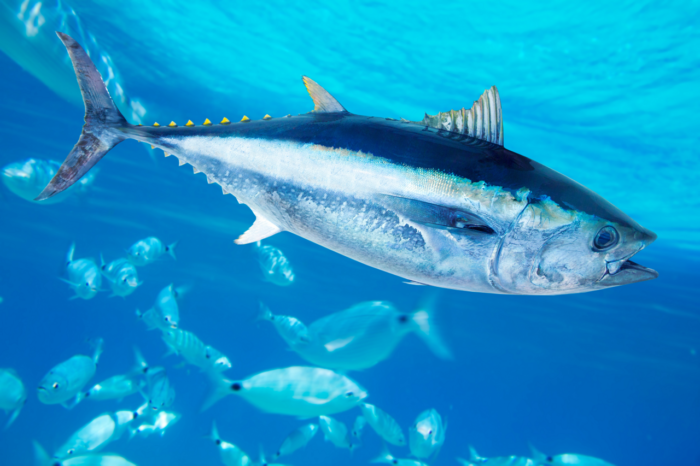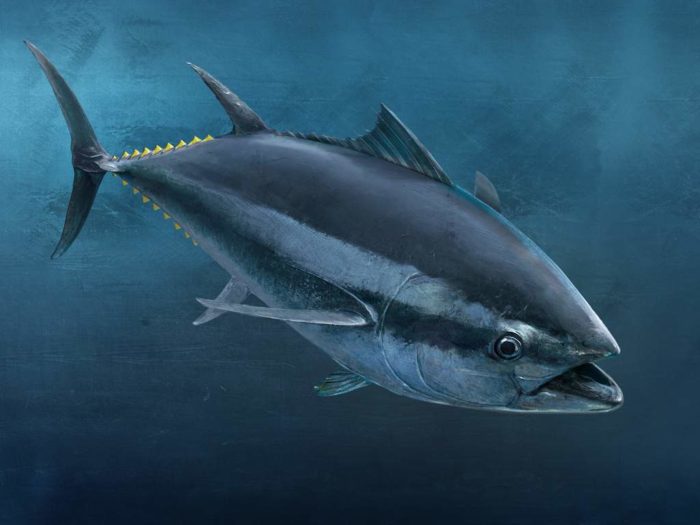Tuna is one of the most famous and popular fish used as food around the world. It belongs to the mackerel family and has great economic importance in the fishing and processing industries. Tuna is known for its meaty, juicy, and protein-packed fillets, which are prepared in a variety of ways, including grilled, boiled, fried, baked, or used for sushi.
Description of the fish
Tuna is a large marine predatory fish belonging to the Scombridae family. It has a slender, smooth and elongated body shape that can reach lengths of up to 3 meters and weigh more than 600 kg.The color of the tuna ranges from dark blue to greenish-gray on the back, while the sides and belly are white. It differs from other fish in its elongated body shape, which allows it to develop very high speeds and swim far.
The tuna's head is large, with large eyes and a sharp mouth with numerous teeth. The front side of the head is covered with small scales that help the tuna move in the water. The dorsal fin is located almost in the middle of the body and is very long, and the adipose fin helps the fish maintain balance in the water. It also differs from other fish in its excellent muscles, which makes it a popular target for sport fishing.
It is found in all tropical and temperate latitudes. This is a predatory fish that migrates long distances in search of food and suitable conditions for spawning. Some of the most popular tuna fishing destinations include the Indian Ocean, Pacific Ocean and Atlantic. Tuna can live both close to the shore and in the open ocean at depths of up to 500 meters.
Historical reference
Two thousand years ago, the Phoenicians were fishing for tuna, which lives in the Mediterranean Sea. The ancient Greeks, observing them, gave this fish the name thynō, which translates as “throwing”. Aristotle wrote about this type of fish in his History of Animals, and Pliny suggested that eating tuna dishes was beneficial for those suffering from ulcers.
Opinions regarding tuna varied widely. During the era of feudal Japan, it was said that even cats despised him. Probably one of the factors behind the rejection was the risk of food poisoning. Warm-blooded fish spoiled quickly, so before the invention of refrigeration, they were usually thrown away.
And now the Japanese consider bluefin tuna the most valuable fish in the world and treat it with the same reverence as the French treat truffle dishes. In the middle of the last century, the annual tuna catch was around one million tons, but since purse seines were invented, this figure has risen to 4 million tons. Unfortunately, this has led to some tuna species being close to extinction.
Beneficial features
Tuna includes several types. The most famous are:
- Black.
- Red.
- Blue.
- Yellowtail.
They all differ slightly in appearance and habitat, but their beneficial properties are similar.
100 grams of tuna contain the following beneficial substances:
- protein – 29 g;
- fat – 6 g;
- carbohydrates – 0 g;
- cholesterol – 48 mg;
- sodium – 44 mg;
- zinc – 0.7 mg;
- vitamin A – 68 mg;
- vitamin C – 0 mg;
- vitamin B6 – 0.5 mg;
- vitamin B12 – 10.7 mcg;
- vitamin d – 5 mg;
- vitamin E – 0.4 mg;
- calcium – 13 mg;
- manganese – 0.1 mg;
- niacin – 10 mg;
- selenium – 36 mcg;
- phosphorus – 250 mg;
- potassium – 310 mg;
- magnesium – 60 mg;
- iron – 1.3 mg.
100 grams of fish contain about 184 calories. It is also rich in Omega-3 fatty acids, which are considered very beneficial for cardiovascular and brain health. Omega-3 fatty acids help lower blood cholesterol, improve blood flow and reduce the risk of developing cardiovascular disease. In addition, they affect brain function, increasing concentration and memory.
This is a unique fish that has the ability to maintain heat in the main parts of its body. Its gills are 30 times larger than those of other aquatic inhabitants.
The best type for consumption is young with light-colored flesh, because it has not had time to accumulate mercury in its body, and its meat is still soft and tender.
Tuna has many benefits that can benefit human health.
- Eating this fish will help improve your vision thanks to the Omega-3 acids it contains, which are known to prevent macular degeneration, a common cause of vision loss in older people.
- Tuna is also good for heart health, as it helps reduce the risk of blood clots and increases good cholesterol levels while reducing inflammation.
- In addition, this fish is known to reduce the risk of developing various types of cancer, such as colon, oral, stomach, esophagus and ovarian or breast cancer.
- Additionally, it helps regulate metabolism and insulin response, controlling body weight and preventing obesity or diabetes.
- It also helps brain health by supporting nerve impulses and reducing the risks of inflammation, while protecting against Alzheimer's disease.
- Selenium contained in tuna helps detoxify the liver, neutralizing harmful substances accumulated in it.
- Its regular use leads to a good mood, as it significantly reduces stress levels and increases the production of serotonin.
Harm to humans
Representatives of the Mackerel family are capable of accumulating mercury in their bodies, so they are not recommended for consumption in large quantities by vulnerable groups of the population, such as pregnant women suffering from toxicosis, nursing mothers and adolescents. Additionally, Pacific tuna should be avoided by people with kidney complications and allergies.Children aged 12 years and over can eat up to 100 grams of fish per week.
Unfortunately, mercury poisoning does not show any symptoms at first, but later leads to coordination problems, speech delays, hearing loss and muscle weakness in addition to neurological problems. Both fetuses in the womb and infants are particularly susceptible to the damaging effects of this heavy metal.
Tuna contains purines, and too much of these substances in the body leads to gout and urolithiasis. Eating fish also sometimes causes food allergies, which are accompanied by symptoms such as dizziness, nausea, nasal congestion, watery eyes, skin rash, swollen throat and difficulty breathing.
Application
In addition to the traditional use of this fish in cooking, it is also used by nutritionists to create a diet for people who want to normalize their weight. Ordinary tuna is a very tasty and nutritious fish.
Medicine
Tuna itself is not a medicine, but it is recommended to use it to treat vitamin and mineral deficiencies, including in its raw form, cut into thin slices. Nutritionists advise including tuna in the diet of those who are struggling with obesity, since this fish can suppress the feeling of hunger. It is highly recommended for people who are looking to lose weight or gain muscle mass as it contains low amounts of fat but high amounts of protein, which is essential for our muscles.
Cooking
Tuna is a universal product. It can be used to prepare various dishes, such as sushi, salads, snacks and soups. The best part is located in the abdominal area.People often enjoy tuna carpaccio—thin slices of raw meat—as an appetizer, or prepare it as steaks or fillets, bake it, and even marinate it.
Delicious recipe for tuna with spaghetti and zucchini
Ingredients:
- 2 tuna fillets (about 150 grams each).
- 250 grams of spaghetti.
- 2 medium zucchini.
- 2 cloves of garlic.
- 1/4 cup olive oil.
- Salt and pepper to taste.
- Lemon juice (optional).
- Fresh parsley (for garnish).
Recipe:
- Cut the tuna into medium-sized pieces and sprinkle with salt and pepper to taste.
- Heat 1/8 cup olive oil in a frying pan over medium heat.
- Fry the tuna pieces in the pan for 2-3 minutes on each side until they are golden brown. Transfer to a plate and set aside.
- Cut the zucchini into thin round slices and mince the garlic.
- Add another 1/8 cup olive oil to the pan and sauté the zucchini and garlic for 4 to 5 minutes until softened.
- Cook spaghetti according to package instructions until done.
- Mix the prepared spaghetti with the fried zucchini and garlic, add the remaining oil and stir.
- Place the spaghetti and zucchini on a plate and top with the seared tuna pieces.
- Sprinkle the dish with fresh parsley and, if desired, add fresh lemon juice.
Serve warm and enjoy!
Storage recommendations
Tuna is available throughout the year, but the best catches usually occur between late spring and early fall. The fillet should be firm and dense with a reddish or dark red color and a unique flavor. The thicker the piece of tuna, the juicier it will be when cooked.
Canned fish is also a good product. The most recommended varieties are skipjack tuna and albacore.
If you do not plan to cook fresh fish immediately, place the fillets on a plate, cover with plastic wrap, and store in the refrigerator. For canned fish, different rules: transfer the contents to a glass jar with a lid and store in the refrigerator for no more than 24 hours.
















